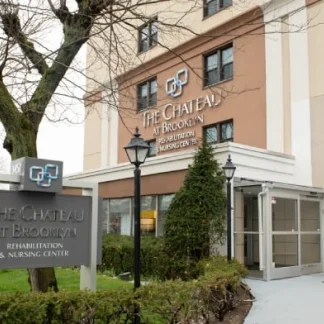Restorative Management Corporation
Restorative Management Corporation is an inpatient rehab located in Brooklyn, NY...
Chateau At Brooklyn is a private rehab located in New York City, New York. Chateau At Brooklyn specializes in the treatment of Mental Health.
Contact us for more information: (718) 535-5100

Connect with Chateau At Brooklyn by calling their admissions team directly.
(718) 535-5100 Website Get DirectionsExercise therapy (also known as active rehabilitation) consists of a regimen of physical activities prescribed by a physiotherapist to help a patient recover from conditions that impact movement and quality of life. Physical therapy exercise is used to address both common and more complex injuries and conditions. It focuses on moving the body and its different parts to relieve symptoms, improve mobility and levels of fitness. This includes gait training, neuro re‐education and customized therapeutic exercises designed to improve agility, balance, coordination, flexibility, range of motion, strength and muscle endurance and performance-specific activity.
Gait training physical therapy (gait rehabilitation) is the act of learning how to walk after sustaining an injury or disability. A physiotherapist will facilitate the process of relearning how to walk through therapeutic exercises such as walking on a treadmill, lifting legs, sitting down, standing up, stepping over objects and completing various muscle strengthening activities. The goals of gait training include increased muscle strength, better coordination, improved voluntary response in lower limb muscle groups. It can also help enhance cardiovascular fitness, flexibility, weight-bearing and balance.
Occupational Therapy (OT) helps people who are experiencing difficulty in day-to-day activities due to injury, illness, or disability. This includes occupational therapy for the elderly. From self-care (getting dressed, eating, moving around the house) and being productive (going to work or school, participating in the community) to leisure activities (physical activities, social activities), an Occupational Therapist helps patients develop, recover, improve, as well as maintain the fine motor and cognitive skills needed for daily living.
Physiotherapy can provide relief for cervical, back, and neck pain. A physiotherapist will typically use a combination of different therapies such as electrical stimulation, ergonomic supports, heat, ice, joint mobilization, massage for lower back pain, ultrasound, soft tissue mobilization, traction, and therapeutic exercises. The goal of neck rehabilitation and physiotherapy for back pain is to reduce pain and inflammation while increasing mobility.
Gait training physical therapy (gait rehabilitation) is the act of learning how to walk after sustaining an injury or disability. A physiotherapist will facilitate the process of relearning how to walk through therapeutic exercises such as walking on a treadmill, lifting legs, sitting down, standing up, stepping over objects and completing various muscle strengthening activities. The goals of gait training include increased muscle strength, better coordination, improved voluntary response in lower limb muscle groups. It can also help enhance cardiovascular fitness, flexibility, weight-bearing and balance.
Occupational Therapy (OT) helps people who are experiencing difficulty in day-to-day activities due to injury, illness, or disability. This includes occupational therapy for the elderly. From self-care (getting dressed, eating, moving around the house) and being productive (going to work or school, participating in the community) to leisure activities (physical activities, social activities), an Occupational Therapist helps patients develop, recover, improve, as well as maintain the fine motor and cognitive skills needed for daily living.
Physiotherapy can provide relief for cervical, back, and neck pain. A physiotherapist will typically use a combination of different therapies such as electrical stimulation, ergonomic supports, heat, ice, joint mobilization, massage for lower back pain, ultrasound, soft tissue mobilization, traction, and therapeutic exercises. The goal of neck rehabilitation and physiotherapy for back pain is to reduce pain and inflammation while increasing mobility.
Occupational Therapy (OT) helps people who are experiencing difficulty in day-to-day activities due to injury, illness, or disability. This includes occupational therapy for the elderly. From self-care (getting dressed, eating, moving around the house) and being productive (going to work or school, participating in the community) to leisure activities (physical activities, social activities), an Occupational Therapist helps patients develop, recover, improve, as well as maintain the fine motor and cognitive skills needed for daily living.
Physiotherapy can provide relief for cervical, back, and neck pain. A physiotherapist will typically use a combination of different therapies such as electrical stimulation, ergonomic supports, heat, ice, joint mobilization, massage for lower back pain, ultrasound, soft tissue mobilization, traction, and therapeutic exercises. The goal of neck rehabilitation and physiotherapy for back pain is to reduce pain and inflammation while increasing mobility.
Physiotherapy can provide relief for cervical, back, and neck pain. A physiotherapist will typically use a combination of different therapies such as electrical stimulation, ergonomic supports, heat, ice, joint mobilization, massage for lower back pain, ultrasound, soft tissue mobilization, traction, and therapeutic exercises. The goal of neck rehabilitation and physiotherapy for back pain is to reduce pain and inflammation while increasing mobility.
Restorative Management Corporation is an inpatient rehab located in Brooklyn, NY...
Housing Plus Solutions is a private rehab located in Brooklyn, New York. Housing...
Brooklyn Campus of the VA NY Harbor Healthcare System is a public rehab located ...
Bridging Access to Care operates an Office of Mental Health (OMH) Licensed Outpa...